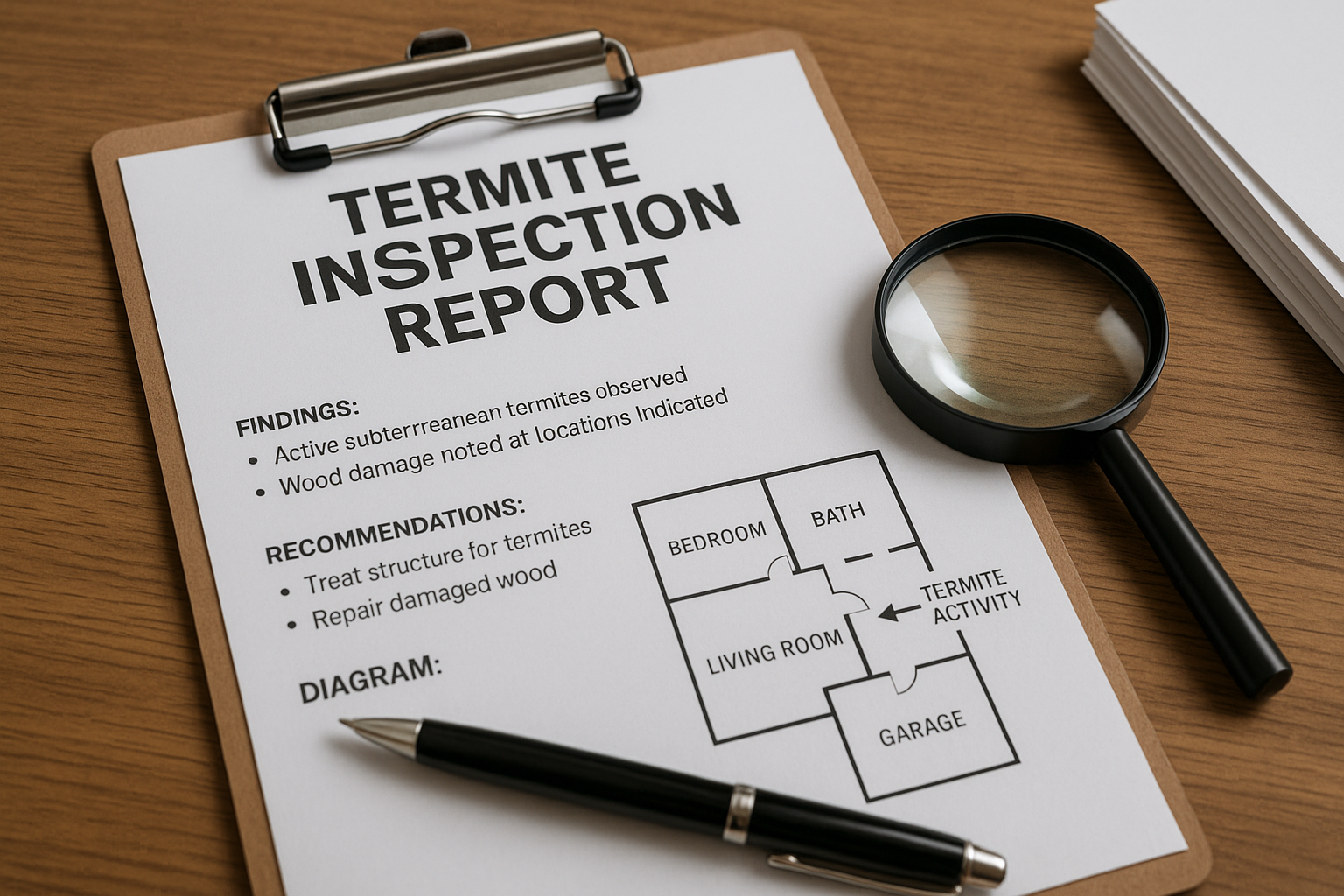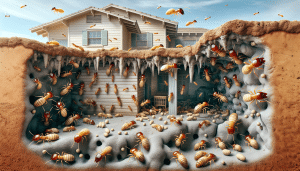Staring at a Termite Inspection report can feel a lot like trying to read a medical diagnosis in a foreign language while your wallet slowly catches fire. It’s overwhelming, confusing, and honestly, a little bit terrifying when you see checkboxes ticked next to words like “structural damage” or “live infestation.” But take a deep breath, because understanding this paperwork is the absolute best way to protect your biggest investment.
Contents
- 1 The WDIIR: What Is It, Anyway?
- 2 Deciphering Section I: The General Info
- 3 The Scary Part: Evidence of Infestation
- 4 Understanding “Conducive Conditions”
- 5 The Obstructions: What We Couldn’t See
- 6 The Graph: X Marks the Spot
- 7 Arizona Specifics: The Subterranean Threat
- 8 Recommendations: The Action Plan
- 9 When to Call for a Second Opinion
- 10 Don’t Let the Paperwork Panic You
The WDIIR: What Is It, Anyway?
You’ll hear us throw around the acronym WDIIR a lot. It stands for Wood-Destroying Insect Inspection Report. In the pest control industry, specifically here in Maricopa County, this isn’t just a casual checklist. It is a formal, state-regulated document that tells the story of your home’s history with wood-eating Pests.
Here is the thing. Most people only see these reports when they are buying or selling a house. It’s high stakes. You have a closing date looming, a lender demanding paperwork, and suddenly a guy with a flashlight is telling you there are bugs eating the wall studs. It’s stressful.
But for us at Arizona Termite Control, this report is a roadmap. It tells us where the enemy is hiding, how they got in, and what we need to do to kick them out. It covers more than just termites, too. It looks for wood-boring beetles, carpenter ants, and carpenter bees, though let’s be real—in Arizona, 99% of the time, we are talking about Subterranean termites.
Deciphering Section I: The General Info
The top of the report is pretty standard stuff—addresses, license numbers, that sort of thing. But don’t skip it entirely. You want to make sure the report lists the specific structures that were inspected.
If you have a detached garage, a guest casita, or a wooden shed in the backyard, were those checked? If the report only says “Main Structure,” and you have termites eating your detached workshop, you might not know until the roof sags. Always verify the scope of the inspection.
The Scary Part: Evidence of Infestation
Okay, this is where your heart might start racing. The inspector has to mark whether they found visible evidence of wood-destroying insects. They usually break this down into two very distinct categories, and knowing the difference can save you a panic attack.
Active Infestation
This means the party is currently happening. The inspector found live insects, fresh mud tubes (those little tunnels termites build to travel across concrete), or recent damage. If you see “Active,” you need Treatment immediately. There is no waiting around.
Previous Evidence
This is where it gets tricky. You might see a box checked for “Evidence of Previous Infestation.” This doesn’t necessarily mean you have a problem right now. In Arizona, houses change hands often. A home built in the 90s in Phoenix has likely had termites at least once.
If the inspector finds old, dry, crumbling mud tubes but no live bugs, it might just be a scar from an old battle that was already won. However, and this is a big however, if there is no paperwork proving a past treatment, we have to assume the colony might still be lurking underground, waiting for the chemical barrier to wear off.
Understanding “Conducive Conditions”
You know how doctors tell you to lower your cholesterol to avoid a heart attack later? That is exactly what the “Conducive Conditions” section is. It lists things that aren’t problems yet but are basically rolling out the red carpet for termites.
Termites need three things: cellulose (wood), moisture, and shelter. If your home offers these, they will find it.
Common conducive conditions we see in the valley include:
- Earth-to-Wood Contact: This is the big one. If your wood siding touches the dirt, or if you have a patio post buried in the ground, termites can walk right in without building a shelter tube. They stay invisible.
- Excessive Moisture: Leaky hose bibs, A/C condensation lines dripping near the foundation, or sprinklers hitting the house. Termites love soft, wet soil.
- Faulty Grade: If the dirt around your house slopes toward the foundation instead of away, water pools there. It’s like a spa day for termites.
- Debris: Old lumber, firewood, or cardboard boxes stacked against the house or in the crawlspace (if you have one).
Fixing these issues is often something you can do yourself on a weekend, and it makes a huge difference in preventing future attacks.
The Obstructions: What We Couldn’t See
Here is a little industry secret: a termite inspection is visual. We can’t see through walls (we wish we could), and we can’t move your heavy antique armoire.
The report will list obstructed areas. These are places the inspector couldn’t check. In a typical garage, for instance, walls are often lined with storage boxes, shelving units, or a water heater. If there is a termite tube behind that stack of holiday decorations, the inspector can’t report it because they can’t see it.
Why does this matter?
If a report says “No Evidence Found,” but 40% of the perimeter was obstructed by dense vegetation or stored items, that “No Evidence” comes with a giant asterisk. It just means we didn’t see them in the 60% we could look at.
The Graph: X Marks the Spot
Most reports come with a graph or a diagram of the home’s footprint. This is often the easiest part to read.
| Symbol | What it Usually Means | Context |
|---|---|---|
| A | Active Infestation | Live bugs or fresh tubes found here. |
| E | Evidence (Inactive) | Old tubes or damage, no live bugs seen. |
| X | Obstruction | Something blocked the view (bush, AC unit, etc.). |
| C | Conducive Condition | Moisture or wood-to-earth contact area. |
| D | Damage | Structural wood has been compromised. |
Look at the clusters. Is all the activity on the north side near the bathroom plumbing? That tells a story about moisture. Is it spread out everywhere? That suggests a massive, mature colony surrounding the home.
Arizona Specifics: The Subterranean Threat
You have to understand that Arizona is different. In other parts of the country, you worry about rot or carpenter ants. Here, Heterotermes aureus (our local desert termite) is aggressive. They are small, they are hungry, and they are incredibly adapted to our dry heat.
They live deep in the soil where it’s cool and moist. They build those famous shelter tubes to travel up your concrete stem wall to get to the tasty framing of your house.
When you read your report, look for mentions of “shelter tubes” or “mud tunnels.” This is the hallmark of the subterranean termite. If the report mentions “pellets” or “sand-like droppings,” that might indicate Drywood termites, which are a totally different beast requiring different treatments (sometimes tenting). But in Maricopa County, it’s almost always the subterranean variety coming up from the ground.
Recommendations: The Action Plan
The final part of the report is the recommendation. If the inspector found evidence, they will recommend treatment.
This is where homeowners get confused. “Do I need to treat the whole house, or just that one spot?”
Let me explain. Spot treatments (treating just the area where bugs were found) can work, but they are risky. Termite colonies are massive. If you block them at the front door, they might just go around to the back window. In Arizona, a complete perimeter treatment—creating a continuous barrier around the entire foundation—is usually the smartest play. It seals the fortress.
Also, look for recommendations regarding drilling. To treat effectively, we often have to drill small holes in the concrete patios or driveways to inject the termiticide into the soil below. It sounds destructive, but it’s standard procedure and we patch it up nicely.
When to Call for a Second Opinion
Sometimes, a report can feel vague. Maybe it says “potential damage” or “inaccessible areas” and leaves you guessing. Or maybe the recommended treatment seems wildly expensive.
You know what? It is okay to ask Questions. Actually, you should ask questions. If the report says there is damage, ask: “Is this structural, or just cosmetic?” “Is this fresh, or from ten years ago?”
If the report feels alarmist or if the inspector didn’t take the time to explain the findings to you, get a second set of eyes on it. We see reports all the time where a “shadow” was called a termite tube, or conversely, where a major infestation was missed because someone didn’t look behind the water softener.
Don’t Let the Paperwork Panic You
Look, a termite report is just data. It’s information you can use to make a decision. Whether you have a few old tubes that need cleaning off or a live colony eating your garage framing, everything is fixable. Concrete and wood can be repaired; soil can be treated.
The only unfixable termite problem is the one you ignore.
So, if you are holding a report that looks like it was written in hieroglyphics, or if you just found something that looks suspiciously like a mud tube on your stem wall, don’t sit on it. We have been reading these reports and protecting Arizona homes for years. We know the difference between a minor scar and a major threat.
Let us take a look at it for you.
We can review your report, give you a second opinion, or come out and verify the findings ourselves. Don’t let the bugs win by default.
Call Arizona Termite Control today at 480-660-3093.
Or, click here to [Request a Free Inspection]. Let’s get that peace of mind back where it belongs—in your home.




